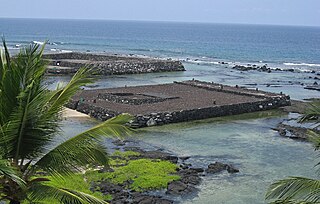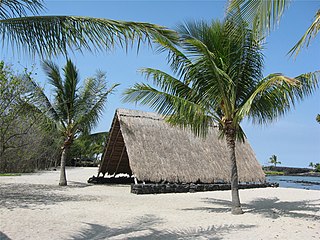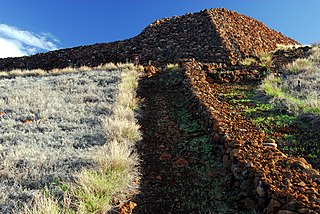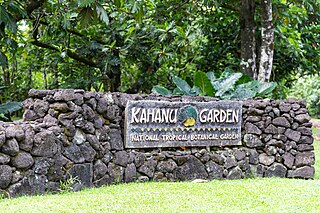Related Research Articles

Mauna ʻAla in the Hawaiian language, is the Royal Mausoleum of Hawaii and the final resting place of Hawaii's two prominent royal families: the Kamehameha Dynasty and the Kalākaua Dynasty.

Puʻuhonua o Hōnaunau National Historical Park is a United States National Historical Park located on the west coast of the island of Hawaiʻi in the U.S. state of Hawaii. The historical park preserves the site where, up until the early 19th century, Hawaiians who broke a kapu could avoid certain death by fleeing to this place of refuge or puʻuhonua. The offender would be absolved by a priest and freed to leave. Defeated warriors and non-combatants could also find refuge here during times of battle. The grounds just outside the Great Wall that encloses the puʻuhonua were home to several generations of powerful chiefs.

Kealakekua Bay is located on the Kona coast of the island of Hawaiʻi about 12 miles (19 km) south of Kailua-Kona. Settled over a thousand years ago, the surrounding area contains many archeological and historical sites such as religious temples (heiaus) and also includes the spot where the first documented European to reach the Hawaiian islands, Captain James Cook, was killed. It was listed in the National Register of Historic Places listings on the island of Hawaii in 1973 as the Kealakekua Bay Historical District. The bay is a marine life conservation district, a popular destination for kayaking, scuba diving, and snorkeling.

In ancient Hawaii, a luakini temple, or luakiniheiau, was a Native Hawaiian sacred place where human and animal blood sacrifices were offered.

Kohala Historical Sites State Monument includes the National Historic Landmark Moʻokini Heiau and the birthplace of Kamehameha I. It is located in remote North Kohala on the Island of Hawaiʻi.

Kaloko-Honokōhau National Historical Park is a United States National Historical Park located in the Kona District on the Big island of Hawaiʻi in the U.S. state of Hawaiʻi. It includes the National Historic Landmarked archaeological site known as the Honokōhau Settlement. The park was established on November 10, 1978, for the preservation, protection and interpretation of traditional native Hawaiian activities and culture.

A heiau is a Hawaiian temple. Made in different architectural styles depending upon their purpose and location, they range from simple earth terraces, to elaborately constructed stone platforms. There are heiau to treat the sick, offer first fruits, offer first catch, start rain, stop rain, increase the population, ensure the health of the nation, achieve success in distant voyaging, reach peace, and achieve success in war (luakini).

Puʻukoholā Heiau National Historic Site is a United States National Historic Site located on the northwestern coast of the island of Hawaiʻi. The site preserves the National Historic Landmark ruins of the last major Ancient Hawaiian temple, and other historic sites.

Kahanu Garden and Preserve is a botanical garden located on the Hana Highway near Hana, Maui, Hawaii. It is one of five gardens of the non-profit National Tropical Botanical Garden, the others being McBryde, Allerton, and Limahuli Garden and Preserve on Kauaʻi, and The Kampong in Florida.
The Hokukano-Ualapue Complex is a National Historic Landmarked pre-contact archaeological site on several properties adjacent to Hawaii Route 450 in Ualapue, on Molokaʻi island. The complex includes six heiaus and two fishponds. The complex is one of the most important collections of native Hawaiian sites in Hawaiʻi. It was designated a National Historic Landmark in 1962 and added to the National Register of Historic Places on October 15, 1966.

Kamakahonu, the residence of Kamehameha I, was located at the north end of Kailua Bay in Kailua-Kona on Hawaiʻi Island.

Loʻaloʻa Heiau is located in Kaupo on Maui. It is one of the few remaining intact examples of a large luakini heiau. Once the center of an important cultural complex, oral tradition attributes the construction of the temple at about 1730 AD to Kekaulike, King of Maui, who lived at Kaupo and died in 1736. Its site number is HASS-50-MA-A28-1. It was excavated in 1931. It was designated a National Historic Landmark in 1962.

Halekiʻi-Pihana Heiau State Monument is a 10-acre (4.0 ha) park containing two important luakini heiau on a high ridge near the mouth of ʻIao Stream in Wailuku, Maui. Both Halekiʻi and Pihana were associated with important Hawaiian chiefs, have been closely studied by archaeologists, and overlook the fertile Nā Wai ʻEhā region irrigated by the Wailuku, Waikapu, Waiheʻe and Waiehu streams. The heiau complex was added to the National Register of Historic Places on 25 November 1985.

Kahaluʻu Bay is a historic district and popular recreation area on the Kona coast of the Big Island of Hawaiʻi.

Ahu A ʻUmi Heiau means "shrine at the temple of ʻUmi" in the Hawaiian Language. It is also spelled "ahu-a-Umi", or known as Ahua A ʻUmi Heiau, which would mean "mound of ʻUmi". It was built for ʻUmi-a-Liloa, often called ʻUmi, who ruled the island of Hawaiʻi early in the 16th century. He moved the seat of government here from the Waipiʻo Valley. The seat of power generally remained in the Kona District until the plantation days hundreds of years later. Ahu A ʻUmi Heiau was also the place where the great chief Keawenuiaʻumi hid to escape death from a strong aliʻi, Kalepuni, who attempted to take over Keawe's rule. The site was an enclosure surrounded by a number of stone cairns, up to four meters high and seven meters in diameter.

Hōlualoa Bay is a historic area between Kailua-Kona and Keauhou Bay in the Kona District of the Big Island of Hawaiʻi. The community now called Hōlualoa is uphill from this bay. The name means "long slide" in the Hawaiian Language, from the long trail that went from a forest on the slopes of Hualālai, to a site where the logs were made into canoes into this bay where a large royal building complex was built over several centuries.

Pua'a-2 Agricultural Fields Archeological District is a historic site of Ancient Hawaii agriculture on the Big Island of Hawaiʻi.

Ulupō Heiau on the eastern edge of Kawai Nui Marsh in Kailua, Hawaiʻi, is an ancient site associated in legend with the menehune, but later with high chiefs of Oʻahu, such as Kakuhihewa in the 15th century and Kualiʻi in the late 17th century. It may have reached the peak of its importance in 1750, before being abandoned after Oʻahu was conquered in the 1780s. The site became a territorial park in 1954, was partially restored in the early 1960s, marked with a bronze plaque by the State Commission on Historical Sites in 1962, and listed on the National Register of Historic Places in 1972.
The Haena Archeological Complex, on Kauai near Hanalei, Hawaii, is an archeological site complex that is listed on the U.S. National Register of Historic Places.
References
- 1 2 "National Register Information System". National Register of Historic Places . National Park Service. July 9, 2010.
- ↑ "Hanakaoe Burial Platform 2501". Office of Hawaiian Affairs. Retrieved December 10, 2013.
- ↑ "Cultural Resources" (PDF). Stryker Brigade Combat Team Draft EIS, Hawai‘i. Archived from the original (PDF) on December 13, 2013. Retrieved December 10, 2013.